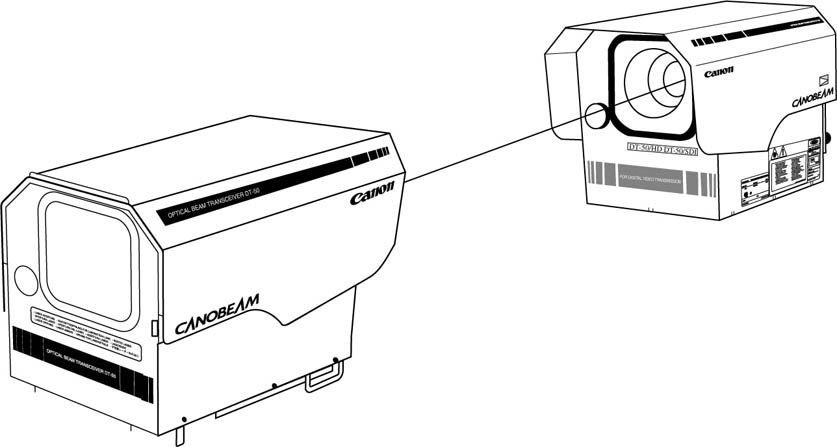Optical links
Infra-red optical video link
An alternative to using microwave signals is to use infrared light signals instead. In principle, this works like your TV remote control, but at very much higher power. An infrared link can be an effective alternative over distances up to 1000 m, and also offers freedom from any regulatory requirement, unlike microwave links used for broadcasting, no licence or permission is required for optical (infrared or laser) links.
The link has a transmitter and a receiver, as with a microwave link, and the units are both tripod mounted allowing transmission of video and audio up to 1 km with direct line of sight. Often, the transmitter and the receiver have built-in telescope sights and signal strength meters (AGC again) to assist in alignment.
The disadvantage of infrared links is their vulnerability to poor weather conditions such as heavy rain, mist or fog, as the wavelength of infrared light is affected by water droplets. The range of the link is optimum in clear weather, and so the distance of 1 km is the maximum that can be achieved – a more realistic working average is typically up to 500 m.
Optical laser link
Working at a much higher frequency, the optical laser link is a more expensive but reliable method of connecting two points without using microwave. As an example, we will look at a particular brand of laser link called Canobeam, made by Canon of Japan, which is widely used in newsgathering and event coverage.
Canobeam is an optical wireless communication system that enables a two-way wireless connection between two points by means of a powerful laser beam – and the distance between the locations can be up to 4.5 km due to the much greater power of the laser emitter. The Canobeam combines the optical accuracy of high quality lenses with the precision of a focussed laser.
Most importantly, unlike microwave signals, the use of Canobeam does not require any frequency allocation or license under telecommunications law in almost any country in the world. We will look at regulatory issues later in the book, but one of the biggest advantages of the optical laser link is that you can obtain as many channels as you need for the programme requirement without regulation. The Canobeam offers bidirectional transmission of four video channels (up to three in one direction) and ten audio channels – hence each end of the link is an integrated transmitter/receiver (termed a ‘transceiver’).
The Canobeam consists of two units – a base control unit and a head unit. The head unit is weatherproof (to a degree) and can be separated from the base unit by up to 50 m. The head unit is fully remote controlled and powered from the base unit.
The setting-up of any optical link – whether it be infrared or laser – is similar to setting-up a microwave link. Adjusting the optical sighting between two points can be very difficult because the laser beam is very narrow. However, the Canobeam has a small high power optical laser sighting system, and a monitoring camera built into the head unit. On the head unit, there is an optical viewfinder for pointing the units at each end so that they are approximately aligned in the correct direction. Each unit has a laser sighting ‘flasher’ which even in clear weather can be seen at up to the maximum operating distance of 4.5 km through the monitoring camera. The power of each transmission laser is then optimized for the distance between the transceiver units.
Canobeam link© Canon Japan

Fine adjustment of the direction of the beam is achieved by finely aligning the mirror in the head unit via a four-way touchpad on the base unit. As the beam reaches near the correct alignment axis, the mirror is locked into the optimum position by an auto-tracking system, which then maintains the optimum alignment by measuring the received signal from the other end.
The same process occurs at the other end of the link, and it generally takes less then 30 min to set up a Canobeam link. However, as with microwave (and unlike the infrared link), the Canobeam has to be used with care. While microwave, infrared and laser signals are all invisible to the eye, both microwave and laser are potentially hazardous. The Canobeam is classified as a Class 3B laser beam, which unlike the Class 1 laser in your CD player, is hazardous to the naked eye. However, the equipment has been manufactured such that the laser beam is diffused, and Canon states that the laser can be viewed directly for up to 7min at a distance of 40 cm from the lens without risk of damage to the eye. Nevertheless, when using such equipment it should be treated with respect.
